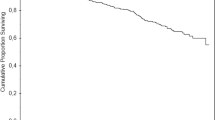Abstract
The National Kidney Foundation Kidney Disease Outcomes Quality Initiative (NKF K/DOQI) guidelines have advocated autogenous arteriovenous fistulae as a primary procedure for hemodialysis access. This study compared the clinical outcomes between autogenous and prosthetic arteriovenous hemodialysis accesses, determining factors contributing to primary and secondary patency and function. Associated risk factors and number of interventions required to maintain secondary patency in each cohort were also assessed. A vascular database review of consecutive hemodialysis access procedures performed during a 36-month period (January 1999 to December 2001) at an academic institution was conducted. Life-table and log-rank analyses were used to analyze patency rates. Univariate and multivariate analysis was used to analyze risk factor influence on patency and function. A total of 231 upper extremity arteriovenous access procedures were performed in 209 patients during this period. One hundred autogenous accesses were created in 100 patients, 68 being forearm Brescia-Cimino arteriovenous fistulae. A total of 131 prosthetic accesses (ePTFE) grafts were also placed during this period in 109 patients. The demographic profiles of both cohorts were similar. Primary patency at 1 and 2 years was 56% (CI 45-76%) and 39% (CI 28-50%), respectively, in the autogenous group, and 36% (CI 26-45%) and 9% (CI 3-14%), respectively, in the prosthetic group. Differences in secondary patency at 1 year and 2 years were not significant (64% [CI 54-74%] and 53% [CI 42-65%] in the autogenous group vs. 65% [CI 55-73%] and 46% [CI 36-55%] in the prosthetic group). Secondary interventions were required in 87% of the prosthetic cohort (average 0.92 procedures/patient/year) and 57% of the autogenous cohort (average 0.53 procedures/patient/year). Multivariate analysis of associated risk factors demonstrated no significant effects on either primary or secondary patency in both groups. Autogenous accesses have superior primary patency and maintain equal secondary patency with significantly fewer interventions. These data strongly support the NKF K/DOQI guidelines recommending creation of autogenous access whenever possible. These outcomes can provide significant health-care cost benefits when using an algorithm favoring primary creation of autogenous access for hemodialysis.


Similar content being viewed by others
References
Atlas of ESRD in the United States. United States Renal Data System. www.usrds.org 2000
D Reddan P Klassen DL Frankenfield et al. (2002) ArticleTitleNational profile of practice patterns for hemodialysis vascular access in the United States. J Am Soc Nephrol 13 2117–2124 Occurrence Handle12138144
NKF K/DOQI Guidelines 2000. Guidelines for Vascular Access. The National Kidney Foundation. www.kidney.org/professionals/doqi/guidelines
The Dialysis Outcomes and Practice Patterns Study (DOPPS). www.dopps.org
J Sands M Perry (2002) ArticleTitleWhere are all the AV fistulas? Semin Dial 15 146–148 Occurrence Handle10.1046/j.1525-139X.2002.00045.x Occurrence Handle12100452
AN Sidawy R Gray A Besarab et al. (2002) ArticleTitleRecommended standards for reports dealing with arteriovenous hemodialysis accesses. J Vasc Surg 35 603–610 Occurrence Handle10.1067/mva.2002.122025 Occurrence Handle11877717
DN Jones RB Rutherford (2000) Evaluation of results, standardized reporting practices, and the computerized vascular registry. Rutherford Vascular Surgery. W.B. Saunders Philadelphia 456–469
ME Cinat J Hopkins SE Wilson (1999) ArticleTitleA prospective randomized evaluation of PTFE graft patency and surveillance techniques in hemodialysis access. Ann Vasc Surg 13 191–198 Occurrence Handle10.1007/s100169900241 Occurrence Handle10072461
KD Gibson DL Gillen MT Caps et al. (2001) ArticleTitleVascular access survival and incidence of revisions: a comparison of prosthetic grafts, simple autogenous fistulas, and venous transposition fistulas from the United States Renal Data System Dialysis Morbidity and Mortality Study. J Vasc Surg 34 694–700 Occurrence Handle10.1067/mva.2001.117890 Occurrence Handle11668326
PE Miller D Carlton MH Deierhoi DT Redden M Allon (2000) ArticleTitleNatural history of arteriovenous grafts in hemodialysis patients. Am J Kidney Dis 36 68–74 Occurrence Handle1:STN:280:DC%2BD3czjsVSqsw%3D%3D Occurrence Handle10873874
RL Pisoni EW Young DM Dykstra et al. (2002) ArticleTitleVascular access use in Europe and the United States: results from the DOPPS. Kidney Int 61 305–316 Occurrence Handle10.1046/j.1523-1755.2002.00117.x Occurrence Handle11786113
BS Dixon L Novak J Fangman (2002) ArticleTitleHemodialysis vascular access survival: upper-arm native arteriovenous fistula. Am J Kidney Dis 39 92–101 Occurrence Handle11774107
H Lee B Manns K Taub et al. (2002) ArticleTitleCost analysis of ongoing care of patients with end-stage renal disease: the impact of dialysis modality and dialysis access. Am J Kidney Dis 40 611–622 Occurrence Handle10.1053/ajkd.2002.34924 Occurrence Handle12200814
RR Mendes MA Farber WA Marston LC Dinwiddie BA Keagy SJ Burnham (2002) ArticleTitlePrediction of wrist arteriovenous fistula maturation with preoperative vein mapping with ultrasonography. J Vasc Surg 36 460–463 Occurrence Handle10.1067/mva.2002.126544 Occurrence Handle12218967
Acknowledgements
We gratefully acknowledge the statistical expertise of Chris Hanks of the University of California Irvine Statistical Consulting Service and “Joseph” Fu L. Wu of the General Clinical Research Center in preparation of this manuscript.
Author information
Authors and Affiliations
Corresponding author
About this article
Cite this article
Perera, G.B., Mueller, M.P., Kubaska, S.M. et al. Superiority of Autogenous Arteriovenous Hemodialysis Access: Maintenance of Function with Fewer Secondary Interventions. Ann Vasc Surg 18, 66–73 (2004). https://doi.org/10.1007/s10016-003-0094-y
Published:
Issue Date:
DOI: https://doi.org/10.1007/s10016-003-0094-y




